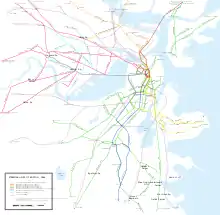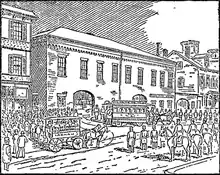South Boston Railroad
The South Boston Railroad was a street railway company that operated in Boston, Massachusetts in the mid-nineteenth century. It provided horsecar service for passengers traveling between South Boston and the city downtown.[1]

History

Originally formed as the Broadway Railroad, the company was incorporated on April 29, 1854 and commenced operations four years later. The original route granted to the railway ran from South Boston Point (now City Point), at the eastern extremity of Fourth Street, to a point near the intersection of Broadway and Turnpike Street (now Dorchester Avenue), where it merged with the tracks of the Dorchester Avenue Railroad. In 1868 the company changed its name to the South Boston Railroad.[2]
By the 1860s the South Boston was one of the four principal street railways of the Boston area, together with the Metropolitan, Union/Cambridge, and Middlesex.[3] Of the four, it was generally on the smaller size, with a passenger count of 4.3 million in 1869 and 6.1 million a decade later.[4]
In early 1887 the railroad experienced a worker's strike that lasted for over a month, causing significant disruptions in service.[5]
In 1887 the West End Street Railway gained a controlling interest in the South Boston, and the railroad was formally consolidated into the West End on November 12 of that year.[6]
Statistics
| FY | Track miles operated |
Miles run | Passengers carried |
Passenger receipts |
Ref. |
|---|---|---|---|---|---|
| 1862 1 | 4.29 | 251,022 | 1,412,034 | $68,787 | [7] |
| 1867 | 6.85 | 468,857 | 3,358,867 | $186,242 | [8] |
| 1872 | 7.68 | 696,422 | 5,509,457 | $290,789 | [9] |
| 1877 | 10.36 | 905,039 | 5,548,609 | $281,765 | [10] |
| 1882 | 14.33 | 1,332,348 | 9,072,394 | $440,215 | [11] |
| 1887 | 19.66 | 1,606,057 | 11,085,052 | $539,440 | [12] |
1. For eleven months only.
Notes
- Cheape 1980, p. 110.
- Hager 1892, p. 17; Massachusetts General Court 1854, pp. 349 ff.
- Pinanski 1908, pp. 10-11; Fifty Years 1938, p. 13.
- Warner 1870, p. 330; Massachusetts Board of Railroad Commissioners 1880, p. 137.
- Toomey & Rankin 1901, pp. 204-06, refers to this incident as "probably the most stirring event in the last quarter of the nineteenth century [in South Boston]." See also Boston Daily Globe 1887a, p. 2; Boston Daily Globe 1887b, p. 2; Boston Daily Globe 1887c, p. 1; Boston Daily Globe 1887d, p. 1; Boston Sunday Globe 1887e, p. 3; Boston Daily Globe 1887f, p. 2.
- Pinanski 1908, pp. 17-18; Public Service Commission 1915, p. 939.
- Warner 1863, pp. 273-74.
- Warner 1868, pp. 251-52.
- Massachusetts Board of Railroad Commissioners 1873, pp. 504-05.
- Massachusetts Board of Railroad Commissioners 1878, pp. 261, 271.
- Massachusetts Board of Railroad Commissioners 1883, pp. 370, 372.
- Massachusetts Board of Railroad Commissioners 1888, pp. 427, 429.
References
- "An Act To Incorporate The Broadway Railroad Company". Act No. Chap. 0444 of 1854. Massachusetts General Court.
- "Horse Railroad Men - They Submit Their List of Grievances". Boston Daily Globe. February 3, 1887. Retrieved December 28, 2019.
- "Tied Up - The South Boston Street Railroad Disabled". Boston Daily Globe. February 7, 1887. Retrieved December 28, 2019.
- "It Means War - Directors and Employes Grimly Firm". Boston Daily Globe. February 8, 1887. Retrieved December 28, 2019.
- "First Move - South Boston Cars Go the Rounds". Boston Daily Globe. February 12, 1887. Retrieved December 28, 2019.
- "Their Side of the Case - South Boston Directors Make a Statement". Boston Sunday Globe. March 13, 1887. Retrieved December 28, 2019.
- "It Is Ended - South Boston Men Vote the Strike Off". Boston Daily Globe. March 16, 1887. Retrieved December 28, 2019.
- Cheape, Charles W. (1980). Moving the Masses: Urban Public Transit in New York, Boston, and Philadelphia, 1880-1912. Cambridge (Massachusetts) and London: Harvard University Press. ISBN 0-674-58827-4.
- Fifty Years of Unified Transportation in Metropolitan Boston. Boston: Boston Elevated Railway Company. 1938.
- Hager, Louis P., ed. (1892). History of the West End Street Railway. Boston: Louis P. Hager.
- Massachusetts Board of Railroad Commissioners (1873). Fourth Annual Report of the Board of Railroad Commissioners, January 1873. Boston: Wright & Potter.
- Massachusetts Board of Railroad Commissioners (1878). Ninth Annual Report of the Board of Railroad Commissioners, January 1878. Boston: Rand, Avery & Co.
- Massachusetts Board of Railroad Commissioners (1880). Eleventh Annual Report of the Board of Railroad Commissioners, January 1880. Boston: Rand, Avery & Co.
- Massachusetts Board of Railroad Commissioners (1883). Fourteenth Annual Report of the Board of Railroad Commissioners, January 1883. Boston: Wright & Potter.
- Massachusetts Board of Railroad Commissioners (1888). Nineteenth Annual Report of the Board of Railroad Commissioners, January 1888. Boston: Wright & Potter.
- Pinanski, Abraham Edward (1908). The Street Railway System of Metropolitan Boston. New York: McGraw Publishing.
- Second Annual Report of the Public Service Commission. 2. Boston: Wright & Potter. 1915.
- Toomey, John J.; Rankin, Edward P. B. (1901). History of South Boston (Its Past and Present). Boston: Toomey and Rankin.
- Warner, Oliver (1863). Returns of the Railroad Corporations of Massachusetts, 182: With Abstracts of the Same. Boston: Wright & Potter.
- Warner, Oliver (1868). Returns of the Railroad Corporations of Massachusetts, 1867: With Abstracts of the Same. Boston: Wright & Potter.
- Warner, Oliver (1870). Returns of the Railroad Corporations of Massachusetts, 1869: With Abstracts of the Same. Boston: Wright & Potter.